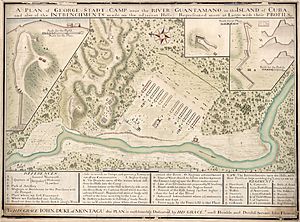Invasion of Cuba (1741) facts for kids
Quick facts for kids Invasion of Cuba |
|||||||
|---|---|---|---|---|---|---|---|
| Part of the War of Jenkins' Ear | |||||||
 Castle of El Morro on Santiago de Cuba |
|||||||
|
|||||||
| Belligerents | |||||||
| Commanders and leaders | |||||||
| Edward Vernon | Francisco de la Vega | ||||||
| Strength | |||||||
| 4,000 regulars & militia 9 ships of the line 12 frigates & other ships 40 transports & store-ships |
950 regulars and militia unknown naval forces |
||||||
| Casualties and losses | |||||||
| 3,445 killed, wounded or missing | 400 killed or wounded 3 warships captured |
||||||
The invasion of Cuba happened between August and December 1741. It was part of a bigger fight called the War of Jenkins' Ear. A combined army and navy force, led by Admiral Edward Vernon and Major-General Thomas Wentworth, arrived near Cuba. They built strong defenses around their landing spot at Cumberland Bay.
Even though they didn't face much fighting, neither leader felt ready to attack the Spanish town of Santiago de Cuba. The British soldiers were often attacked by Spanish groups. More and more soldiers also got sick. Because of this, the British finally left the island after doing nothing for several months.
Contents
Why the Invasion Happened
Admiral Vernon had tried to capture Cartagena earlier in 1741. That attempt was not successful. After his defeat, he decided to lead his sick and tired soldiers to the island of Cuba.
The southern and eastern parts of Cuba were not very populated. They were also far from the capital city, Havana. This meant the British might have been able to set up a lasting base there.
Vernon's Expedition to Cuba
The land forces for this invasion were made up of soldiers who had fought in Cartagena. There were about 3,000 British and American troops. Another 1,000 soldiers from Jamaica joined them.
Admiral Vernon left Port Royal with many ships to try and capture Santiago de Cuba. His fleet included large warships and smaller vessels. There were also 40 transport ships. These ships carried 4,000 troops led by Major-General Thomas Wentworth.
- HMS Boyne (80 guns, Flagship)
- HMS Cumberland (80 guns)
- HMS Grafton (70 guns)
- HMS Kent (70 guns)
- HMS Montague (60 guns)
- HMS Tilbury (60 guns)
- HMS Worcester (60 guns)
- HMS Chester (50 guns)
- HMS Tiger (50 guns)
- HMS Experiment (20 guns)
- HMS Sheerness (20 guns)
- HMS Shoreham (20 guns)
- HMS Alderney (Bomb vessel)
- HMS Phaeton (Fireship)
- HMS Strombolo (Fireship)
- HMS Vesuvius (Fireship)
- HMS Bonetta (Sloop)
- HMS Tryton (Sloop)
- HMS Princess Royal (Hospital ship)
- HMS Scarborough (Hospital ship)
- HMS Pompey (Tender)
The Battle and Retreat

On the night of August 4–5, the British forces landed. They were joined by 1,000 extra soldiers from Jamaica. They landed on three different beaches in Guantanamo Bay. They faced no resistance and marched towards the village of La Catalina.
However, the British slowed down three days later. They were still 105 kilometers (65 miles) from their goal. Major-General Thomas Wentworth, their commander, had growing worries.
Santiago's Governor Francisco Caxigal de la Vega had only 350 regular soldiers. He also had 600 local militia. The Spanish leaders, including garrison commander Carlos Riva Agüero and Captain Pedro Guerrero, decided to retreat from the British.
Wentworth's army became stuck due to tiredness and disease. They spent the next four months camped out. Spanish forces attacked them now and then. Admiral Vernon was very unhappy with his colleague's lack of action. But he did not want to risk his ships attacking the town.
By December 5, many soldiers were sick with fever. About 2,260 soldiers were ill. Because of this, the expedition was called off. The British re-boarded their ships. They sailed away at dawn on December 9 and returned to Port Royal ten days later.
What Happened Next
Admiral Vernon's plan did not achieve anything. Instead, he lost many soldiers. He also faced disgrace when he returned to Britain in 1742.
See also
 In Spanish: Batalla de Santiago de Cuba (1741) para niños
In Spanish: Batalla de Santiago de Cuba (1741) para niños

